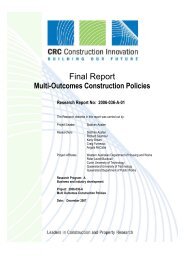Dispute Avoidance and Resolution (literature review) - Construction ...
Dispute Avoidance and Resolution (literature review) - Construction ...
Dispute Avoidance and Resolution (literature review) - Construction ...
You also want an ePaper? Increase the reach of your titles
YUMPU automatically turns print PDFs into web optimized ePapers that Google loves.
• Cost of strained business relations between the contracting partiesWe have not sighted any studies which have attempted to quantify the indirect costs arisingfrom dispute avoidance.Although no data has been uncovered in relation to these various costs it is worthwhile toreflect upon recent findings of a 2006 survey of the Australian construction <strong>and</strong> infrastructureprojects by Blake Dawson Waldron in collaboration with the Australian ConstructorsAssociation. The survey participants were contractors, developers, state <strong>and</strong> federalgovernment employees, financiers, private sector principals <strong>and</strong> consultants who have beeninvolved in Australian construction or infrastructure projects worth $20Million or more in thetime period 2002-2005. Participants were surveyed from October 2005 till January 2006 <strong>and</strong>there were 190 respondents.A significant finding of the survey was that the overwhelming majority of respondents saidthey had ‘invoked a dispute resolution process in their projects’ <strong>and</strong> that the project levelnegotiation (72%) <strong>and</strong> executive negotiation (59%) are the two most commonly used disputeresolution methods. There is an overall preference for negotiated dispute resolution methodsto agree on an outcome to disputes, rather than having a third party impose a decision withconsiderable time <strong>and</strong> cost implications to both parties. The cost of resolving a dispute whenit is decided by a third party is often seen as outweighing the benefits.However this needs to be seen in light of two other key points; firstly although the cost ofresorting to a third party is not borne during the negotiation process is there still aconsiderable cost to the parties involved which are somewhat ‘hidden’ <strong>and</strong> not quantified.Second, even though the direct cost is reduced does this ultimately lead to a satisfactoryoutcome?According to the findings;Less than half of the survey respondents are satisfied that the dispute resolution methodsare used are effective in terms of cost, outcome, time <strong>and</strong> process.‘In projects surveyed 41% of disputes took up to three months to resolve. Of the mostcommon methods of dispute resolution 72% of disputes settled by project level negotiation<strong>and</strong> 59% of disputes settled by executive negotiation are resolved in less than three months.Of the disputes not settled in less than three months 16% took over 12 months to resolve. Ifwe consider the impact of this on a project for the best case scenario – ie for a period ofthree months project participants <strong>and</strong> perhaps senior executives within companies involvedon projects are involved in resolving disputes. The impact upon the project performanceproductivity would be considerable <strong>and</strong> also the impact upon other business operationswould be seriously impeded as senior executives are taken away from more productive <strong>and</strong>strategic aspects of the organisation. The impact of a dispute which took over 12 months toresolve could in many cases be crippling to the organisation.A reason for a delay of over 12 months is the time needed to complete prescribed disputeresolution procedures which involve a third party to either facilitate a negotiated outcome orto impose a decision that resolves the dispute, for example through litigation or arbitration.With regards to satisfactory outcomes; only 33% of respondents were happy with disputeresolution procedures in terms of time, 39% in terms of cost, 22% in terms of process <strong>and</strong>42% in terms of outcome – largely indicating a key finding of the study; there is widespreaddissatisfaction in dispute resolution outcomes. Also in projects worth $200-500million only9% of respondents are satisfied that the dispute resolution process used is effective <strong>and</strong> incontrast for the respondents in the $20-50million range it is 25% <strong>and</strong> for the $50-200 millionit is 24%. In conclusion, for this particular set of respondents, the larger the project the biggerthe dispute tends to be <strong>and</strong> as a result the greater the risk, time <strong>and</strong> costs involved inseeking to resolve it. <strong>Dispute</strong> resolution regimes are typically prescribed in the projectProject 2007-006-EP Page 12 of 62
















